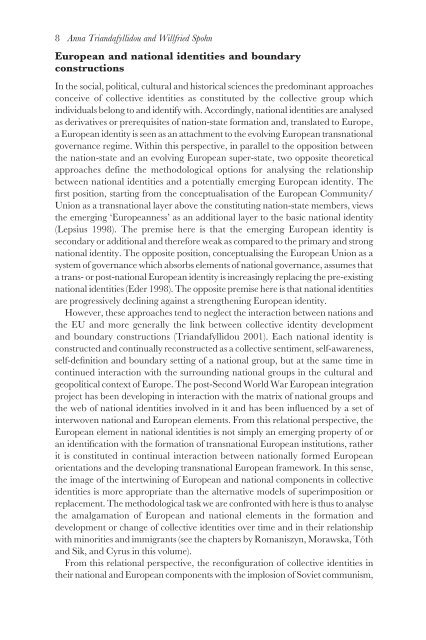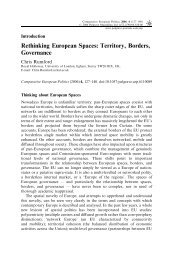Europeanisation, National Identities and Migration ... - europeanization
Europeanisation, National Identities and Migration ... - europeanization
Europeanisation, National Identities and Migration ... - europeanization
You also want an ePaper? Increase the reach of your titles
YUMPU automatically turns print PDFs into web optimized ePapers that Google loves.
8 Anna Tri<strong>and</strong>afyllidou <strong>and</strong> Willfried Spohn<br />
European <strong>and</strong> national identities <strong>and</strong> boundary<br />
constructions<br />
In the social, political, cultural <strong>and</strong> historical sciences the predominant approaches<br />
conceive of collective identities as constituted by the collective group which<br />
individuals belong to <strong>and</strong> identify with. Accordingly, national identities are analysed<br />
as derivatives or prerequisites of nation-state formation <strong>and</strong>, translated to Europe,<br />
a European identity is seen as an attachment to the evolving European transnational<br />
governance regime. Within this perspective, in parallel to the opposition between<br />
the nation-state <strong>and</strong> an evolving European super-state, two opposite theoretical<br />
approaches define the methodological options for analysing the relationship<br />
between national identities <strong>and</strong> a potentially emerging European identity. The<br />
first position, starting from the conceptualisation of the European Community/<br />
Union as a transnational layer above the constituting nation-state members, views<br />
the emerging ‘Europeanness’ as an additional layer to the basic national identity<br />
(Lepsius 1998). The premise here is that the emerging European identity is<br />
secondary or additional <strong>and</strong> therefore weak as compared to the primary <strong>and</strong> strong<br />
national identity. The opposite position, conceptualising the European Union as a<br />
system of governance which absorbs elements of national governance, assumes that<br />
a trans- or post-national European identity is increasingly replacing the pre-existing<br />
national identities (Eder 1998). The opposite premise here is that national identities<br />
are progressively declining against a strengthening European identity.<br />
However, these approaches tend to neglect the interaction between nations <strong>and</strong><br />
the EU <strong>and</strong> more generally the link between collective identity development<br />
<strong>and</strong> boundary constructions (Tri<strong>and</strong>afyllidou 2001). Each national identity is<br />
constructed <strong>and</strong> continually reconstructed as a collective sentiment, self-awareness,<br />
self-definition <strong>and</strong> boundary setting of a national group, but at the same time in<br />
continued interaction with the surrounding national groups in the cultural <strong>and</strong><br />
geopolitical context of Europe. The post-Second World War European integration<br />
project has been developing in interaction with the matrix of national groups <strong>and</strong><br />
the web of national identities involved in it <strong>and</strong> has been influenced by a set of<br />
interwoven national <strong>and</strong> European elements. From this relational perspective, the<br />
European element in national identities is not simply an emerging property of or<br />
an identification with the formation of transnational European institutions, rather<br />
it is constituted in continual interaction between nationally formed European<br />
orientations <strong>and</strong> the developing transnational European framework. In this sense,<br />
the image of the intertwining of European <strong>and</strong> national components in collective<br />
identities is more appropriate than the alternative models of superimposition or<br />
replacement. The methodological task we are confronted with here is thus to analyse<br />
the amalgamation of European <strong>and</strong> national elements in the formation <strong>and</strong><br />
development or change of collective identities over time <strong>and</strong> in their relationship<br />
with minorities <strong>and</strong> immigrants (see the chapters by Romaniszyn, Morawska, Tóth<br />
<strong>and</strong> Sik, <strong>and</strong> Cyrus in this volume).<br />
From this relational perspective, the reconfiguration of collective identities in<br />
their national <strong>and</strong> European components with the implosion of Soviet communism,



